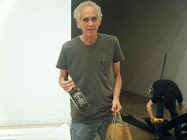Rejecting Ulterior Motifs: How Contemporary Art Wore Out Its Welcome in North Texas
Texas has traditions, held close to the heart. When the fluid culture of our global village arrives on the doorstep of traditional mavens, don’t expect it to be accepted with open arms. After the exhibition Cherry Picked: 2007 Survey of Texas Art and Artists opened in April at the Wichita Falls Museum of Art, a subsequent contemporary show, Ulterior Motifs #12, was removed from the schedule. It was followed by a scathing email from Wayne Gilbert, Motifs organizer and owner of G Gallery in Houston, alleging a $1 million budget revocation by board members appalled at contemporary art being shown in Wichita Falls. When asked to approve the show, board members voted against it 14 to 1. Neither charge has been proven, but the board definitely “did something” about the Ulterior Motifs exhibit.
The WFMA is not used to scrutiny or attention outside of their insulated community of 100,000. Even within Texas they did not look to others for inspiration until recently, and the tight-knit sensibilities of the city were put to the test last month when this bumbling art world overreaction became the latest bullet in a growing list of strange scandals in North Texas.
At the crux of the WFMA’s encounter with the outside world was an invitation extended to curators Rachel Cook (Editor-in-Chief of Glasstire) and Leona Scull-Hons to design the museum’s 40th anniversary exhibit, Cherry Picked. Seemingly as innocuous as the recent Take Me to the River exhibition of contemporary painting and video presented in 2006, Cherry Picked was a bit more ambitious than the museum expected. The exhibit opened to a cautious audience unwilling to embrace video, installation or conceptual artwork and set off a split between patrons of the museum. Experienced in the local scenes of Austin and San Antonio as well as both frequent travelers, the curators each chose ten artists that expressed their views of Texas art. Cook limited her search to artists over 30 whom she believes have made a strong contribution to their locale and Texas at large. Scull-Hons geared her choices toward emerging artists she compares to “cherry blossoms”. Her curatorial inclinations led her to performance and other non-traditional materials as well as paintings and sculptures.
Selected from a burgeoning pool of talent within the state, artists from Dallas and Austin set the tone for the exhibit along with strong representation from San Antonio, Houston, and West Texas balancing the overall vision. They steadied their approach, avoiding replicating the Texas Biennial and its heavily conceptual art and hipster craft bent; as well as steering clear of the WFMA’s mainstay, stereotypical Texas imagery and paintings of cowboys. Taking into account the cultural atmosphere in Wichita Falls, they avoided depictions of sex or violence, circumventing any religious or moral castigation. Most conservative in the show were the paintings of Marco Villegas, minimal abstractions in earthy colors that evoke the Texas prairie with simple, soothing layers of geometric squares. The sculptures of William Canning and Lizzy Wetzel stick close to the herd, drawing straight lines to “Texas” representational imagery through innovative conceptual processes. Canning inflates whimsical inner tubes in steel, while Wetzel adorns cow skulls with shamanistic mystery. Also working in sculpture, Sharon Engelstein’s minimal shapes mute their references to traces of human figures and faces. Austin’s Okay Mountain contributed two artists to the exhibit; the humble drawings of Dan Fabian and Justin Goldwater mimic and ridicule today’s hip comic figuration and tease lilting references out of their subjects. A kissing cousin of these hipster drawings, crafty reworking of fabric and found materials is found in Bunnyphonic’s performance work as well as the psychologically charged needlepoint and stuffed animals of Celia Eberle.
The polarized reaction to the show may seem peculiar, but video artists Jenny Schlief, Robert Boland, and Cauleen Smith brought something to Cherry Picked that illustrates a radically new aestheticism. Smith’s I want to see my skirt invests the narrative of a young Malian girl into a fractured group of videos that explore the expressive qualities of film with varied textures and connotations. Questioning the world in naïve and quirky experiments, Boland’s films are absurd shorts if they are approached without an open mind to his spiritual connotations, as the artist attempts to levitate on shrubbery and wrestle in yogurt. Houston artist Jenny Schlief may have had a scandalous impact even though her masturbatory To the Lady is not included here; Mature Milk, where the artist drinks massive amounts of strawberry milk and pukes on camera, and Shower Party and Girl Star, of Schlief jumping on a hotel bed in her underwear, were enough to push the envelope in Wichita Falls. Other included installations by Chris Sauter and Helen Altman rework domesticity with evocative juxtapositions. Sauter has piled sleeping bags in a corner, hinting at inhabitants by sculpting outstretched arms. The sculpture takes on strong connotations with molded plastic cups scattered across the floor; you can almost hear the snoring. Altman has presented a simple installation here at the WFMA, an open refrigerator with a thawing turkey inside. The surprised gut reactions by viewers are a testament to the artist’s ability to use everyday items with startling effect. Mimi Kato’s designer fantasies are computer-aided photography and video work drawing from Japanese culture but reinterpreted through her life in San Antonio. Photographs of Muslim teenagers in Houston by Soody Sharifi attempt to bridge the gap between cultures by relating everyday American scenarios; hopefully they and others are recognizable here as familial Texan scenes instead of foreign oddities.
Reaction to the exhibit was split between generations but also along cognitive lines. Some patrons “didn’t understand,” but students, young professionals and children latched onto the multimedia experience of the show. The “over 60” crowd, which WFMA Director Cohn Drennan describes as having “a limited palette,” (if you’ll pardon the pun) did not appreciate the forward looking examples of why Texas art is valid in today’s world art market. On the other hand, younger, media-savvy visitors wandered the extensive gallery, marveling at each turn.
In Wichita Falls, as in many places, traditional thoughts on fine art compete with an expanding definition of art today. The board of the WFMA is filled with long-standing members who were pivotal in introducing a museum to the city back in 1967, and they have been patronizing the establishment for nearly a half century. The Wichita Falls Museum of Science, History and Art opened its doors with an exhibit of Western paintings and bronzes by Frederick Remington and Charles Russell provided by Fort Worth oilman Sid Richardson. For over thirty years the museum persisted as a touchstone institution for the city elite, and a satellite of Midwestern State University.
The small town ennui was recently broken with the hiring of Cohn Drennan from Washington DC’s Department of State’s Art in Embassies program. When Drennan arrived at the WFMA he examined the collections, jettisoning science and history from the museum’s objectives based on meager holdings. With a renewed focus on art, the new director mounted several projects: a corporate exhibit of wine-centered paintings titled Pressing Matters: the Sterling Vineyards Collection, Take Me to the River, 160 paintings by sixteen Texas women artists in the ambitious Timeless, and a survey of the museum’s holdings. Within two years of his tenure at the WFMA the director felt comfortable in his position as an arbiter of taste for the community, but the spring exhibit of 2007 proved too much for his audience to handle.
A “collective gasp” swept through those who had established the museum, and when the announcement of another contemporary exhibit following Cherry Picked found itself in front of the board, they did not hesitate to axe it. Tepid excuses about impending renovation funding, repetition within the series of the Ulterior Motifs last shown in Arlington and Dallas (#10 and #11) and the organizers’ late delivery of images do nothing to blunt the reality of the exhibit being crushed after the board saw its contents. Ulterior Motifs #12 drew from a similar vein as Cherry Picked—artists who have established themselves in their respective Texas communities—but the show is rather more conservative and prestigious than the exhibit that did go on show. The WFMA has missed an opportunity to exhibit works by international stars Robert Rauschenberg, The Art Guys and Mel Chin along with nationally recognized artists Trenton Doyle Hancock, Al Souza, James Surls and David McGee. Additionally, Wayne Gilbert, with his airing of grievances, may have missed his chance to influence Wichita Falls at a later date and to have a positive impact on the development of Midwestern State University, students, the community and families.
In the long run, the spring of 2007 should be regarded as a pivotal time for the WFMA, emerging recently from obscurity to join adventurous art spaces in out of the way places like the Beeville Art Museum and the Old Jail Art Center in Albany, Texas; embracing contemporary art as a matter of civic pride and potential tourism dollars. By pushing the envelope with their 40th anniversary exhibit, the museum has a chance to begin a dialogue within the community on the nature of art. Already visitors and membership are up. A younger generation is discovering the museum for the first time, and their commitment to a new way of thinking will dictate the direction in which the institution will have to go.
via
artshouston






















0 comments:
Post a Comment